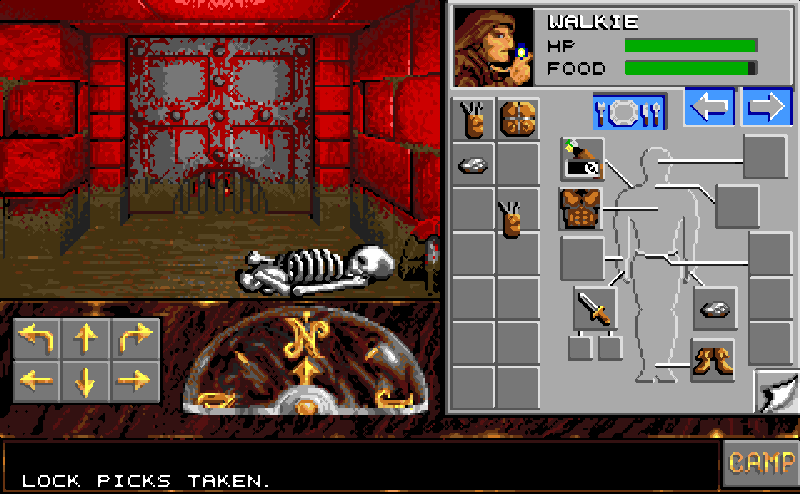

Rest can be interrupted by wandering monsters. The amount of time spent resting depends on how wounded the characters are or how many spells are being learned. Resting is used to heal the party and to memorize or pray to learn spells. The "Camp" button contains a number of important functions, including resting the party, dropping party members (in excess of the starting four), and saving or loading the game. Each spellcaster has an inventory of spells and a certain number of points to spend learning spells (which can be used to learn the same spell multiple times in order to use it more than once), and using a spell expends one use of that spell. Rather than using magic points as in most role-playing games, spellcasters must memorize or pray to learn spells in advance. Characters are revived with a single hit point and starving. If a character is slain in battle, the character is dead until revived by a spell. Characters earn experience and items from defeating monsters in combat. Mages, clerics, and paladins can be ordered to cast spells by selecting their spellbooks or crosses (in their off-hands) with and then selecting a spell from the list that appears. A character can be ordered to attack by selecting a weapon in his or her hand with. Battles are played in real-time and start as soon as a monster appears (without a transition to a separate battle scene). While exploring the dungeon, encounters with malevolent creatures happen randomly. The party finds rations in the dungeon, which can be eaten by placing it on the plate in the character's inventory screen. If a character is starving, the character loses a hit point for every 24 hours of in-game time and cannot memorize or pray for spells. In addition to hit points, each character has a food level, which goes down as time passes. The player can also view the character's statistics by selecting the page flip icon, including the character's current level and experience points. Each character has a backpack containing unequipped items, a quiver that can be filled with arrows for use with a bow, and a belt pouch that can be filled with items that need to be quickly accessed in battle (such as throwing weapons, which are automatically transferred from the belt pouch to the character's hands when spent in combat). Clicking on a party member shows the character's complete inventory, including equipped weapons and armor. The lower characters are in the rear and can only use ranged weapons and spells. These are the only characters able to attack with melee weapons, and they take the brunt of the damage. The two characters on the top of the list are in the front of the party. The character list shows all of the party members with the equipment in their primary hands and off-hands and their current hit points. The player can move through the dungeon by pressing the arrow buttons with the cursor, but the player can also move more quickly through the dungeon by holding START and pressing any direction on the D-Pad. The player can interact with objects in the dungeon, including picking up items (to place in a character's inventory) or pressing buttons and flipping levers. The game shows a first-person view of the dungeon, direction arrows and a compass for navigation, a status area for messages, and a list of party members. The game has options to change the cursor movement speed and to automatically snap the cursor to buttons and objects on the screen.

or performs the selected action (equivalent to a mouse click).

Using a control pad, the D-Pad moves the cursor and speeds up the cursor movement. It can be played using a standard control pad or with the Sega Mouse. The game uses a point-and-click interface to navigate the maze-like dungeon and fight monsters. The default party, if chosen, consists of a male human fighter (neutral good), a female gnome thief (true neutral), a male elf mage (lawful evil), and a female half-elf cleric (neutral good). When forming a new party, the player creates four characters and chooses each character's race, gender, class, alignment, portrait, and name. At the start of the game, the player can choose to create a new party or use a default party. The player controls four characters initially, but this can be increased to a maximum of six characters by resurrecting skeletons found in the dungeon or by finding NPCs. The game does not provide maps of the levels, so players typically draw a map while playing or use an existing one from an outside resource.
#EYE OF THE BEHOLDER MAPS PC#
The game is a dungeon crawler using a first-person perspective in a three-dimensional environment, in a manner similar to the earlier PC game Dungeon Master.


 0 kommentar(er)
0 kommentar(er)
